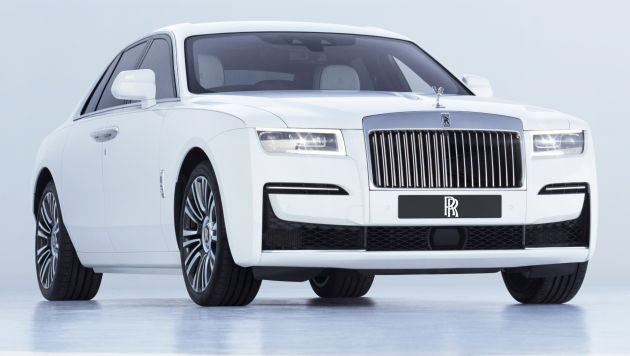2021 Rolls-Royce Ghost unveiled – new aluminium architecture shared with Phantom, 563 hp 6.75L V12
Eleven years after the Rolls-Royce Ghost marked a new entry point to the Spirit of Ecstasy, there’s now a new one. Meet the second-generation Ghost, which ditches its déclassé BMW underpinnings for a version of Goodwood’s bespoke architecture – the same one found underneath the Phantom and Cullinan.
But first, a little bit of background. The Ghost was the most successful car Rolls-Royce had ever produced, but with the world in the grip of a steepening recession (the ongoing coronavirus pandemic certainly isn’t helping matters), an abject demonstration of wealth is apparently being considered poor taste – because rich people who buy multi-million-ringgit vehicles clearly sympathise with the average Joe.
The Ghost, then, had to be cleaner, less ostentatious – Rolls-Royce calls the new design philosophy “Post Opulence”. The company says the new car is the purest expression of its identity, uninterrupted by shutlines. Of course, a Rolls-Royce can’t be too subtle, so the Ghost debuts an illuminated version of the imposing grille, albeit with brushed surfaces on the backs of the metal bars to dial down the effect.
While we’re on the subject of the front end, the leading bonnet shutline is further forward and is now in line with the grille, meaning that the Spirit of Ecstacy sits in its own “lake” of metal. The rectangular headlights emphasise the width of the car (the new Ghost is 30 mm wider than before, in case you’re wondering) to effect a greater presence, and they now feature laser technology and C-shaped daytime running lights.
Along the side, the roofline features a subtle curve that flows towards the tapered rear end, suggesting movement. Rolls-Royce claims that Ghost owners drive their cars as much as they are chauffeured in them, so the window area is split evenly between the front and rear doors. A single line links the front end to the rectangular tail lights (now with a slight forward tilt), with another line down the flanks.
Opening the suicide doors is easier than ever, thanks to power assistance (you can, of course, still shut the door with the press of a button). Step inside, and you’ll find a similarly pared-back environment, but one that continues to feature all the amenities, plushness and mind-boggling attention to detail one could ever ask.
The dashboard is dominated by a single piece of wood veneer, and for the first time, buyers can choose from a variety of open-pore finishes – including the new Obsidian Ayous and Dark Ember – in addition to the traditional high-gloss options. Rolls-Royce has also added an Illuminated Fascia on the passenger side, which glows with the Ghost nameplate and 850 “stars”, just like the Starlight Headliner.
Speaking of which, the Starlight Headliner now displays a shooting star effect and can effectively function as a large speaker, thanks to the exciter speakers on the 18-speaker, 1,300-watt sound system. This system has an adaptive function that uses two microphones to listen for any missing or overemphasised frequencies, adjusting the amplifier output to suit.
Air quality is an important topic given the current global situation, so it’s fitting that the Ghost debuts the new Micro-Environment Purification System (MEPS). This feature detects if airborne contaminants are reaching an excessive amount and automatically switches on recirculation mode, directing all air through a nanofleece filter that removes nearly all ultra-fine particles in under two minutes.
Elsewhere, the Ghost continues to utilise a version of BMW’s iDrive system with twin instrument and infotainment screens. It features all the latest technologies, including a WiFi hotspot, a 360-degree camera system, a 7×3 head-up display and parking assist.



The car also gets the usual driver assistance systems, such as collision warning, adaptive cruise control, lane departure warning and blind spot monitoring with rear cross traffic alert, plus a feature called vision assist with day- and nighttime wildlife and pedestrian warning.
The first Ghost was based on the steel monocoque structure of the F01/F02 7 Series, but the new car trades all that for the aluminium spaceframe of its larger siblings (Rolls-Royce initially called it the Architecture of Luxury, but even it now finds the name too pompous for its own good). Make no mistake; the new Ghost is all new – the only bits it shares with the old one are the Spirit of Ecstasy and the in-door umbrellas.
With the new underpinnings, the company could position the front wheels further forward, putting the engine behind the axle. To accommodate this repositioning without impinging on interior space, the Ghost has grown sizeably – in addition to being 30 mm wider (to 1,978 mm), the car is also some 89 mm longer at 5,546 mm, and that’s before the inevitable long-wheelbase model arrives.



The also-aluminium body shell has been hand-welded at four corners simultaneously, eliminating unsightly seams. The addition of laser-welded aluminium doors also reduce weight, provide 40,000 Nm per degree of stiffness and let less outside noise in compared to steel items.
Noise-reduction measures are aplenty, including a felt layer sandwiched within the double-walled bulkhead and floor and more than 100 kg of insulation in the doors, roof, between the double-glazed windows, inside the tyres and almost the entire structure itself. Every component has been inspected for excess noise, with even the air-conditioning ducting polished for a calmer cabin.
But the cabin can’t be too quiet. Complete silence can be disorienting, so some sound actually had to be engineered back in, with each component tuned to resonate a single frequency. The seat frames are damped, and some ports have been added under the boot floor to allow disruptive frequencies to escape – all to make the Ghost’s interior sound more harmonious. A resonance chamber built into the sill section also allows the entire body to function as a subwoofer for the sound system.
Rolls-Royce has also re-engineered the suspension. Called the Planar Suspension System after a geometric plane, it features a number of enhancements and technologies to keep the ride just as flat and level as its namesake. In a world-first, the front upper wishbones have their own dampers for an even more stable ride, while the Flagbearer function scans the road ahead and prepares the air suspension to soak up any bumps.
With the introduction of the new bespoke platform, the Ghost also jettisons the 7 Series’ 6.6 litre V12 in favour of the Phantom’s 6.75 litre unit. In this application, this twin-turbocharged mill has been tuned to deliver 563 hp at 5,000 rpm and a whopping 850 Nm of torque at 1,600 rpm. Paired to a ZF eight-speed automatic gearbox, it enables this 2.5-tonne leviathan to go from zero to 100 km/h in just 4.8 seconds.
Part of this turn of speed comes down to a new addition to the Ghost’s arsenal, all-wheel drive. Every car gets all-paw traction as standard, as well as rear-wheel steering to aid agility. The rearward placement of the engine also gives the Ghost a claimed 50:50 weight distribution.















The post 2021 Rolls-Royce Ghost unveiled – new aluminium architecture shared with Phantom, 563 hp 6.75L V12 appeared first on Paul Tan's Automotive News.
from Paul Tan's Automotive News
Read The Rest:paultan...





Post a Comment